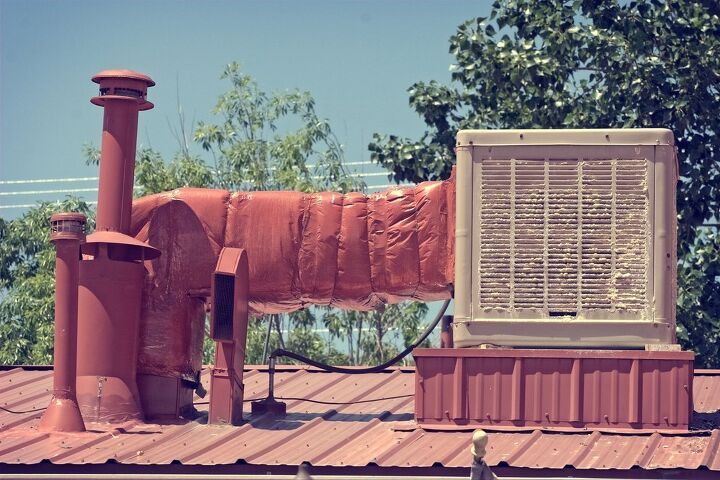How To Prevent Calcium Build Up In A Swamp Cooler (Do This!)

A swamp cooler, also referred to as an evaporative cooler, are air conditioning units keep your home cooler in the summer months by circulating air through wet pads. These devices tend to work best in areas that are hot and dry. Although most water contains naturally occurring calcium and minerals, water in these hot and dry areas tends to be especially mineral-rich.
Maintain and clean your swamp cooler and use high-quality cooler pads to prevent a calcium buildup. Add a bleed-off valve to your swamp cooler to reduce mineral heavy water. Drain your swamp cooler completely after each use and at the end of the season to prevent calcium buildup.
Fortunately, there are steps you can take to prevent the buildup of calcium in your swamp cooler. By doing this, you will effectively improve cooling, increase airflow, and extend the life of your unit.
Do You Need Swamp Cooler Repair or Service?
Get free, zero-commitment quotes from pro contractors near you.

Hard Water and Your Swamp Cooler
Roughly 85% of all homes in America have hard water – water with high levels of calcium and magnesium. If you have hard water, you must be very diligent about the cleaning and maintenance of your swamp cooler, and make a conscious effort to reduce scale build-up.
Your swamp cooler uses the water supply to cool your home and since water is running constantly throughout the system, hard water will cling to virtually anything. In warm months when your swamp cooler is on all the time, water is being pushed through the water lines, pump, distribution tubes, and cooler pads at a consistent rate.
Hard water, or calcium, buildup can develop on all of these different components. As a result, the amount of water and saturation is reduced, severely limiting your swamp cooler’s cooling capacity.
How to Prevent Calcium Build Up in Swamp Cooler
There are a number of ways that you can reduce the issues caused by hard water and effectively prevent calcium build up in your swamp cooler. These preventative measures include:
- Early-season maintenance
- Implementing quality cooler pads
- Regular cleaning
- Adding a bleed-off valve
- Shutting the unit down at the end of the season
Early-Season Swamp Cooler Maintenance
Before you start up your swamp cooler every year, it’s a great idea to take care of some pre-season maintenance. Begin each cooling season by performing a thorough cleaning of your swap cooler. By cleaning the water reservoir and pads every spring, you will greatly improve the performance of your cooler and reduce calcium build-up. To do this, follow the steps outlined below:
- Unplug your swamp cooler from the wall outlet and turn off the water supply.
- Remove the back panel of the cooler to access the fiber pads. Remove these as well as set them aside.
- Drain the water from the inside of the swamp cooler by siphoning with a hose or simply opening the drain plug.
- Use a stiff-bristled brush to clean the inside of the unit and a shop vacuum to remove accumulated dust and dirt.
- Pour white vinegar into the cooler’s water reservoir and let it soak for up to an hour before draining it out into a bucket.
- Scrub the base of the reservoir and rinse with clean water. If you have any leaks in the reservoir let it dry completely and seal up the holes with a silicone sealant.
- Use a few drops of lubricating oil to lubricate the motor and fan.
- Roll out fiber padding and use the old pads as a guide to cut the new ones.
- Install the new cooling pads in the back and sides of the swamp cooler.
- Turn the water supply back on and let the reservoir fill up.
- Replace the back panel, plug the cooler back in, and test operation.
Use Quality Cooler Pads
The quality of the cooler pads that you select can make a significant difference when it comes to calcium build up. Opt for Aspen cooler pads, inspect them often throughout the season, and switch them out as needed. The fibers in Aspen cooler pads soak up water, conduct it resourcefully as a water curtain, and enhance the unit’s cooling effect.
To prevent significant build up in the system, the filters should be changed as often as scale occurs. This usually means that the cooling pads should be changed about two to three times a season. However, you may need to change them more often if the water that services your home is particularly high in minerals.
Regular Cleanings
In addition to performing a pre-season cleaning, you should also clean the interior of your swamp cooler regularly. For regular cleanings, you do not need a commercial product, a simple mixture of water and household white vinegar will suffice. Once a month, you should clean the water pan reservoir at the bottom of the unit. This will effectively prevent minerals from depositing inside the cooler.
You should also drain the reservoir completely and scrub the inside with the same solution, rinsing thoroughly when complete. Consider treating the inside of the reservoir with a scale removing product to increase the solubility of the minerals and keep them from sticking to the cooling pads.
It’s also a great idea to clean the water curtains and filter every two weeks. Wash them with some lukewarm water and a mild detergent. Clean and rinse all the outer components as well to remove any dirt, grime, or debris and keep everything functioning efficiently.
Add a Bleed-Off Valve
Another effective solution for preventing calcium buildup is to introduce a bleed-off valve to the system. Add the bleed-off valve to the water line that brings water from the reservoir to the Aspen filters. It helps to divert a percentage of the recycled water through plastic tubing to an area of your lawn or garden that can house mineral-rich water. Such areas include a water run-off, Bermuda grass, or salt grass.
Bleed-off valves can be found at your local home improvement center or from various online retailers. They are installed on the waterline, six inches above the pump connection.
Shut Down the Unit
Once the season is over, you should complete some more essential swamp cooler maintenance. When you’re done using it for the season, drain it completely and give it one final cleaning to remove any debris or calcium build up. If your particular swamp cooler has a fan-only mode, run it for around an hour to dry everything completely after it has been emptied and cleaned.
Then, cover the unit with a canvas cover for protection during the winter months. This cover not only protects the unit itself, it also prevents cold drafts from entering your home. When you’re ready to shut the system down, always turn it off at the switch inside your home and the one on the unit. The switch on the unit is typically located at the top, on the underside of the top cover.
Swamp cooler maintenance before the season, during, and after, helps to minimize the buildup of calcium and other minerals that can reduce the efficiency of your swamp cooler. The small amount of time that you spend on cleaning and maintenance can significantly extend the life of your cooler.
Do You Need Swamp Cooler Repair or Service?
Get free, zero-commitment quotes from pro contractors near you.

Related Questions
How do you descale a swamp cooler?
To remove calcium deposits on a swamp cooler, combine water and three cups of white distilled vinegar in a bucket. With a wire brush, use this mixture to scrub the venting, drain pan, blades, water float, around the pump, the outside of the unit, and anywhere that has calcium. Once you’re done cleaning, rinse all the components with clean water.
Can I put essential oils in my swamp cooler?
Yes, essential oils can be used in your swamp cooler. In fact, swamp cooler can give off rather musty odors. Adding fifteen drops of an essential oil such as lavender, peppermint, lemon, or a combination of oils can reduce these smells and make the unit have a more pleasant odor. You can also mix the essential oils with vinegar in a spray bottle and spray the inside of the cooler after it has been cleaned.

Jessica considers herself a home improvement and design enthusiast. She grew up surrounded by constant home improvement projects and owes most of what she knows to helping her dad renovate her childhood home. Being a Los Angeles resident, Jessica spends a lot of her time looking for her next DIY project and sharing her love for home design.
More by Jessica Stone



























